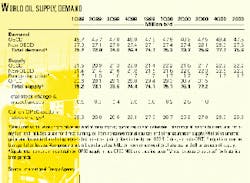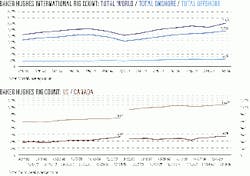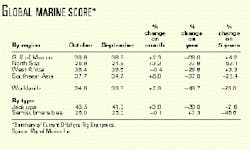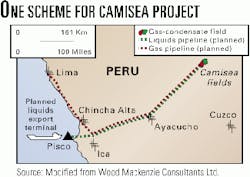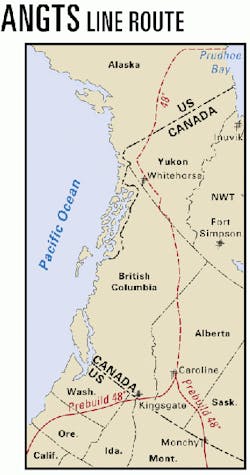Market Movement
IEA sees oil market cooling off
IEA, in its December Oil Market Report (OMR), suggests that the market is easing after all. Industry stocks of crude oil in OECD countries are up, refining margins are down, and demand growth is mixed.
This suggestion is coupled with a warning that stocks have not returned to comfortable levels, however, and that "only when stocks build ahead of peak demand can market instability be trimmed."
Although inventories remain low by historical standards, IEA reports that OECD stocks moved up 7.6 million bbl in October to total 2.56 billion bbl. This, along with the fact that prices did not spike at the start of December when 2.3 million b/d of Iraqi exports were withheld, leads to the conclusion that the market must be well supplied with oil.
This special analysis of the IEA's Oil Market Report and its effects on the international oil market was provided by Marilyn Radler, Economics Editor.
Supply-demand outlook
IEA estimates that world oil production averaged 78.94 million b/d in November, up 730,000 b/d from October. Because Iraqi exports declined by 205,000 b/d when prices were switched from dollars to euros, total OPEC supply fell in November, but the 65,000 b/d loss was more than made up for by non-OPEC countries, where output surged by 795,000 b/d.
The call on OPEC has been revised downwards for the fourth quarter, as the forecast was raised for non-OPEC supply and reduced for global oil demand (see table). Fourth quarter demand is now estimated at 77.7 million b/d, down from 77.9 million b/d in the previous OMR. According to the report, demand growth in OECD countries is strong in North America, modest in Europe, and slowing in Asia.
IEA anticipates a slowdown in deliveries of oil in mainland China early next year after the third quarter's reported growth of 720,000 b/d, or 16.6%. Also slowing Asian demand growth is Japan, where weakness is now proving to be greater than previously anticipated.
Heading into winter, concerns about product availability-with low heating oil stocks in North America-have propped up oil prices. Continued Middle East tensions, uncertainty about weather, and potential supply reductions from OPEC are also helping to sustain strong oil prices.
Refining margins decline
These strong crude prices weakened US Gulf Coast refining margins in November and early December as feedstock costs increased and product prices dipped. WTI cracking margins were little changed, but Brent cracking margins were especially affected by rising tanker rates and fell to an average -$0.90/bbl from $1.11/bbl in October.
In Rotterdam, hydroskimming margins decreased to $0.77/bbl from $3.88/bbl a month earlier, while cracking margins averaged -$0.69/bbl, also down more than $3 from October.
Singapore refining margins were especially hard hit as the price of Dubai crude moved up in a market of weak local product prices. Hydroskimming margins in Singapore averaged -$1.16/bbl in November, while cracking margins fell to $0.56/bbl from $2.96/bbl in October.
Most but not all product prices were weak in November. Cold weather and historically high natural gas prices boosted spot heating oil prices in New York Harbor by 5.5%. Jet fuel prices also moved up, but prices for all other products fell sharply at New York Harbor. The price of gas oil inched up in Rotterdam, going against that market's general decline.
null
null
null
Industry Trends
THE PROFITABILITY OF OFFSHORE DRILLING RIGS CONTINUES TO IMPROVE
Houston-based offshore drilling contractor Global Marine reports its Summary of Current Offshore Rig Economics (SCORE) for October increased to 34.8, up 2.9% from September (see table).
SCORE compares the profitability of current mobile offshore drilling rig rates with the profitability of rates at the 1980-81 offshore drilling cycle peak, when speculative rig construction was common. Global Marine's SCORE then averaged 100%, and new contract day rates equaled the sum of daily cash operating costs plus $700/day/$1 million invested. SCORE reflects current rig day rates as a percentage of the estimated rate required to justify building new rigs on speculation.
October's SCORE is up 49.7% from the same month a year ago and is down 23% from the same month 5 years ago.
Global Marine Chairman, CEO, and Pres. Bob Rose said, "An increase of nearly 50% is an impressive recovery, yet at 34.8, SCORE suggests that we have a long way to go before economics justify widespread speculative building of rigs."
AGA says that almost half of US homes may be able to choose their own natural gas supplier.
AGA said that nearly half the US households with gas service can, or soon may be able to, buy from a supplier other than their local utility.
AGA said its updated study demonstrates the continued growth of competition in the gas industry. It said that nearly 26 million of the nation's 54 million households with gas service (nearly 49%) soon will be able to buy from a nonutility supplier.
It said consumers in 23 states and the District of Columbia have that choice-and one in five households actually has switched suppliers.
Bruce McDowell, AGA director of policy analysis, said, "With energy prices on the rise, households that may not have previously considered purchasing their natural gas from a marketer may be thinking about it. While there is no guarantee of savings, consumers may find some of the nonutility programs to be attractive."
AGA noted that, traditionally, utilities buy gas for residential customers and pass along the cost of the commodity to customers through their monthly bills. The utilities typically do not profit on the sale of gas itself but earn a regulated rate of return on delivery of the gas.
More than 95% of large-volume gas customers, such as factories and electric-power plants, can select their own suppliers. Similarly, almost 70% of commercial customers, such as hospitals and office buildings, have such a choice.
Government Developments
IOGCC says that US natural gas production needs federal incentives.
IOGCC this month urged the next Congress to enact incentives aimed at increasing US gas production. The 30-state group approved a resolution, during its annual meeting in San Antonio, that asked Congress and the next president to focus national attention on the increased demand for gas. IOGCC also urged Congress and the president to develop a national energy policy that increases access to public lands for gas production by eliminating unnecessary and duplicative regulations.
The resolution said technological advances have enabled the industry to cost-effectively produce gas while still protecting the environment.
EPA has unveiled underground storage tank compliance program initiatives.
EPA may ask Congress for more authority to regulate storage tank system components not under EPA jurisdiction, such as leak detection or other aboveground equipment, said a spokesman for the agency late last month.
"We haven't determined whether we need to amend regulations or go to Congress for additional authority," said Timothy Fields Jr., assistant administrator for EPA's Office of Solid Waste and Emergency Response, adding that the agency would evaluate whether regulations are working and, if necessary, determine what changes should be made. It will also examine what improvements might be needed to improve the performance of tank systems. Since the beginning of an EPA program, launched in 1984 to address the threat to groundwater by chemical leaks from underground storage tanks, 1.4 million noncompliant storage tanks have been upgraded or replaced.
Over the next 3 years, EPA will work to bring into compliance the remaining 15% of underground storage tanks and complete another 160,000 spill site cleanups. Fields said the EPA intends to "work aggressively" with government and industry to ensure that the remaining number of noncompliant tanks meet EPA standards by 2005.
PAPUA NEW GUINEA HAS ASKED AUSTRALIA FOR UP TO $650 MILLION (AUS.) TO HELP IT TAKE A DIRECT INTEREST IN THE PROPOSED 3,500-KM GAS PIPELINE FROM PAPUA NEW GUINEA TO QUEENSLAND.
Papua New Guinea has already raised $190 million (Aus.) from the European Investment Bank but needs a further $650 million to fund the major wet gas component of the project. Any Australian contribution would come on top of the $300 million in budget aid that it contributes to Papua New Guinea each year. Under Papua New Guinea resources legislation, the government is entitled to take up to 30% in the project. The request has the support of project participants led by Chevron.
Operatorship of the project may change once development gets under way. ExxonMobil, with a 30% stake, could take over from Chevron, which has 9%, once the government allows the pipeline and allied construction to proceed.
Quick Takes
Peru HAS SIGNED DEVELOPMENT AND TRANSPORTATION contracts for THE Camisea gas project.
The new Peruvian government headed by Pres. Valentin Paniagua signed the development and transportation contracts for the long-awaited Camisea natural gas project. He said that his government would propose a natural resource tax on gas production to promote economic development in Peru's southeastern region, especially Cuzco, where the Camisea fields are located (see map).
A consortium led by Argentina's Pluspetrol, in partnership with Hunt Oil and South Korea's SK Corp., on Feb. 16 won the contract to exploit the Camisea fields with a royalty of 37.24%.
Tecgas, a unit of Techint Group, leads the consortium for transportation and distribution of Camisea gas and liquids, in partnership with Hunt, SK, Sonatrach, and Peru's Graña y Montero.
The consortium bid $1.45 billion to construct and operate the pipeline. The companies have up to 44 months to start up operations but agreed to make every effort to begin commercial operations within 36 months. The Camisea fields, discovered by Royal Dutch/Shell Group in the mid-1980s, have estimated reserves of 13 tcf of gas and 600 million bbl of condensate.
In other development action, Panaco said it completed two wells in the Gulf of Mexico. The East Breaks Block 1107 No. A-12 well is producing 3 MMcfd of gas and 10 b/d of condensate through a 20/64-in. choke with 1,650 psi flowing tubing pressure. The producing interval is 6,546-6,626 ft. The West Delta No. 32 well is producing 2.2 MMcfd of gas through a 12/64-in. choke with 1,225 psi flowing tubing pressure.
Swift Energy said the Rimu-B2 well in the Taranaki basin in New Zealand flowed on test up to 1,384 b/d of 46° gravity crude and 9.4 MMcfd of gas through a 32/64-in. choke with 2,389 psi flowing tubing pressure. The open-hole test included sections of both Upper Tariki sandstone and Upper Rimu limestone at 11,221-11,647 ft.
Conoco IS MAKING PLANS to develop two UK North Sea discoveries.
Conoco said that two appraisals confirmed discoveries in the UK central North Sea that could yield estimated gross reserves of more than 100 million boe, once developed.
Conoco is evaluating the fields, one oil and the other gas, and plans to develop them and begin production in late 2003 or early 2004. The Kappa oil discovery, which also has a small gas cap, is in Block 15/29b and extends into Block 21/4a-North. It is 125 miles northeast of Aberdeen, 16 miles from the Britannia production platform and 13 miles from the Chevron-operated Alba oil field. Conoco holds a 23% equity interest in Alba. Kappa was discovered late in 1999 and confirmed last month by the 15/29b-13 well, which encountered 135 ft of hydrocarbons. A 25-ft interval was perforated and flowed 1,400 b/d of oil through a 24/64-in. choke. Conoco said each Kappa production well could produce up to 20,000 b/d.
The gas discovery, made in 1985 in Block 21/3a, is 26 miles from Britannia and 23 miles from Alba. It was confirmed by the 21/3a-7 well, which encountered a 120-ft gas column. A drill stem test of an 87-ft interval flowed 20 MMcfd through a 44/64-in. choke. Once developed, the field will produce at peak 100-200 MMcfd of gas.
MMS WILL SUSPEND ROYALTIES ON THE FIRST 87.5 MILLION BOE THAT CHEVRON PRODUCES from Green Canyon Block 236 field off Louisiana.
The field, also known as Typhoon, is 173 miles southwest of New Orleans and lies partially in water deeper than 800 m. Chevron operates the leases covering Green Canyon field, which also includes Green Canyon Block 237.
The Deep Water Royalty Relief Act, signed by Pres. Clinton in November 1995, allows the Department of the Interior to grant royalty suspension on both producing and nonproducing fields in water deeper than 200 m to promote development, increase production, or encourage marginal production of Gulf of Mexico leases.
In other production news, Shell Exploration BV and Brovig ASA awarded Expro International Group two contracts worth a combined £28 million related to new production facilities off Iran and Tunisia. The £18 million Shell contract calls for Expro to work with Swire Pacific Offshore, an affiliate of John Swire & Sons, to provide and operate an early production system in Soroush field off Iran. The companies have acquired a jack up production unit and will upgrade processing capacity to 100,000 b/d from 60,000 b/d. They will also install 10 Mw of power generation capacity. Brovig will pay Expro £10 million to provide and operate production facilities on a floating production, storage, and offloading facility for Isis field off Tunisia. Expro will also provide well planning and completion design services to Isis operator Coparex.
Brightening prospects for alaskan north slope gas TOP THIS WEEK'S PIPELINE NEWS.
Principal ANS gas producers BP, Phillips, and ExxonMobil have agreed to a joint work program to study feasibility of a pipeline to move gas from Alaska via Canada to the Lower 48.
In making the announcement, the three producers did not include mention of the long-dormant Alaska Natural Gas Transportation System (ANGTS), which was proposed more than 20 years ago and received the necessary permits for a gas pipeline to extend from the Prudhoe Bay area via Alberta to the Lower 48 (see map, p. 9).
That project was shelved for lack of market, and its sponsors recently have stepped up efforts to revive interest in the project. A competing project would also incorporate a link to the Mackenzie Delta in Canada's Northwest to take in that region's huge untapped gas discoveries (OGJ, Oct. 9, 2000, Newsletter, p. 7).
Over the next year, the companies say that the key program activities will involve conceptual design, project costing, permitting considerations, commercial structure, and overall viability.
"The focus will be on route evaluation and selection leading to a filing of applications with US and Canadian regulatory agencies," said the three major producers. All costs and governance will be shared equally among them. Estimated cost of the initial work program is about $75 million.
Elsewhere on the pipeline front, TransCanada PipeLines applied to federal and Alberta regulators for interim tolls on its Canadian mainline and Alberta natural gas transmission systems. The company asked that interim tolls be made effective Jan. 1. Tolls currently charged by the company expire at the end of this year. The interim tolls would be in effect until TransCanada receives approval for final 2001 tolls. Firm transportation service from the Alberta border to TransCanada's Eastern Zone is commonly used as the benchmark for tolls on the Canadian mainline. TransCanada applied for an interim firm transportation toll of $1.075 (Can.)/MMbtu from the Alberta border to the Eastern Zone, compared with the current toll of $0.96 (Can.)/MMbtu. For the Alberta system, the company applied for an interim firm transportation toll of $0.327/Mcf to its provincial export points, vs. the current toll of $0.310/Mcf.
The Texas Railroad Commission is investigating the rupture of an El Paso Energy-Enron intrastate pipeline Dec. 4. Repairs to the line, commonly known as the Channel Industries intrastate pipeline, were expected to be completed this month. The 300-mile, 30-in. pipeline, which runs from South Texas to the Houston Ship Channel, ruptured earlier this month near Baytown in Chambers County, Tex. El Paso Energy and Enron subsidiary Houston Pipeline are 50-50 owners of the pipeline, which El Paso Field Services operates.
BP, ENI, Spain's Endesa, Gaz de France, and TotalFinaElf will participate with Sonatrach and Cepsa in a feasibility study for the third Algeria-Europe gas pipeline. The study, by JV Medgas-formed by Sonatrach and Cepsa-was announced earlier this year (OGJ Online, Sept. 12, 2000). Sonatrach said the group of firms had been selected from a number of applicants, adding that the companies selected also were active in the Spanish energy sector and had operations in Algeria. The proposed 450-km pipeline would link the port of Beni Saf, in northwestern Algeria, with Almeira, in southern Spain. Sonatrach and Cepsa said the project is technically feasible and economically attractive because of projected increases in European gas consumption. One of the existing pipelines provides Morocco, Spain, and Portugal with 10 billion cu m/year of gas. The second supplies 20 billion cu m/year to Italy via Tunisia.
Turkey's BOTAS Petroleum Pipeline awarded Pipeline Engineering GMBH, Essen, a contract to design the Turkish section of the proposed 1,700 km oil pipeline from Baku, Azerbaijan, to Ceyhan, Turkey. The $2.4 billion line is expected to carry 50 million tonnes/year of crude.
A US CONSORTIUM HEADED BY ENBRIDGE HAS AGREED TO PROVIDE OPERATIONS AND MAINTENANCE SERVICES FOR A MAJOR OIL EXPORT TERMINAL IN NORTHEASTERN VENEZUELA, SAYS PDVSA. The agreement ends months of dispute regarding a $385 million contract signed in 1998 under which Enbridge and its partner Williams were scheduled to purchase the facility at Jose, Anzoategui state.
After Venezuelan Pres. Hugo Chavez took office in February 1999, PDVSA terminated the deal to sell the facility, arguing that the terminal-which handles 800,000 b/d of Venezuelan crude-had strategic sovereign value to Venezuela (OGJ Online, July 17, 2000).
PDVSA also had said the consortium was unable to obtain all the required government permits to move forward on the purchase deal. PDVSA has four strategic associations with foreign oil companies to produce and upgrade 650,000 b/d of extra-heavy crude oil from the Orinoco heavy oil belt. The oil will be shipped through the Jose terminal, which can serve 34 ships/month.
Statoil awarded Linde AG a 65 million kroner preliminary engineering contract for a gas liquefaction plant.
The Norwegian company will build the Snøhvit gas liquefaction plant at Melkøya in northern Norway. The plant will produce LNG from gas supplied from the Snøhvit field development in the Barents Sea off Norway, as well as from nearby Askeladden and Albatross fields. The contract's initial phase will run to next summer but includes two options for Linde to perform further work up to the completion of a possible facility in the autumn of 2006.
Statoil will submit field development plans, including one for a necessary subsea pipeline, to authorities next summer, providing LNG sales contracts have been secured.
In other gas processing news, Mitchell Energy & Development said it would double the capacity of its Bridgeport natural gas processing plant in North Texas during 2001 when it undertakes a second expansion of that facility. Mitchell said construction of the processing train and a related residue sales pipeline is needed to accommodate rapidly growing gas production from Mitchell's Newark East field. The initial plant expansion, to be completed later this month, will increase processing capacity by 100 MMcfd to 310 MMcfd, with maximum production of gas liquids at Bridgeport to increase by 8,000 b/d to 27,000 b/d. Next year's expansion will bring capacity to 430 MMcfd and 37,000 b/d, respectively, when completed next July.
A Paraxylene production unit has started operations in Iran.
A 180,000 tonne/year paraxylene production unit has gone on stream at the Bandar Imam petrochemical complex in Iran, Bandar Imam Petrochemical Managing Director Abbas Sherimoqadam said. He said the project had cost $82 million.
Iran's National Petrochemical Co. last year launched a major expansion of the country's petrochemical sector, including work in the Bandar Imam special petrochemical economic zone (OGJ, Aug. 23, 1999, p. 27). Sherimoqadam told the Iranian News Agency that the unit started tentative operations in October and was operating at 98% of its nominal capacity.
